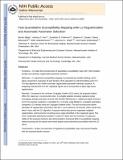| dc.contributor.author | Bilgic, Berkin | |
| dc.contributor.author | Fan, Audrey P. | |
| dc.contributor.author | Polimeni, Jonathan R. | |
| dc.contributor.author | Cauley, Stephen F. | |
| dc.contributor.author | Bianciardi, Marta | |
| dc.contributor.author | Adalsteinsson, Elfar | |
| dc.contributor.author | Setsompop, Kawin | |
| dc.contributor.author | Wald, Lawrence | |
| dc.date.accessioned | 2015-11-03T18:22:03Z | |
| dc.date.available | 2015-11-03T18:22:03Z | |
| dc.date.issued | 2013-11 | |
| dc.date.submitted | 2013-10 | |
| dc.identifier.issn | 07403194 | |
| dc.identifier.issn | 1522-2594 | |
| dc.identifier.uri | http://hdl.handle.net/1721.1/99688 | |
| dc.description.abstract | Purpose
To enable fast reconstruction of quantitative susceptibility maps with total variation penalty and automatic regularization parameter selection.
Methods
ℓ[subscript 1]-Regularized susceptibility mapping is accelerated by variable splitting, which allows closed-form evaluation of each iteration of the algorithm by soft thresholding and fast Fourier transforms. This fast algorithm also renders automatic regularization parameter estimation practical. A weighting mask derived from the magnitude signal can be incorporated to allow edge-aware regularization.
Results
Compared with the nonlinear conjugate gradient (CG) solver, the proposed method is 20 times faster. A complete pipeline including Laplacian phase unwrapping, background phase removal with SHARP filtering, and ℓ[subscript 1]-regularized dipole inversion at 0.6 mm isotropic resolution is completed in 1.2 min using MATLAB on a standard workstation compared with 22 min using the CG solver. This fast reconstruction allows estimation of regularization parameters with the L-curve method in 13 min, which would have taken 4 h with the CG algorithm. The proposed method also permits magnitude-weighted regularization, which prevents smoothing across edges identified on the magnitude signal. This more complicated optimization problem is solved 5 times faster than the nonlinear CG approach. Utility of the proposed method is also demonstrated in functional blood oxygen level–dependent susceptibility mapping, where processing of the massive time series dataset would otherwise be prohibitive with the CG solver.
Conclusion
Online reconstruction of regularized susceptibility maps may become feasible with the proposed dipole inversion. | en_US |
| dc.language.iso | en_US | |
| dc.publisher | Wiley Blackwell | en_US |
| dc.relation.isversionof | http://dx.doi.org/10.1002/mrm.25029 | en_US |
| dc.rights | Creative Commons Attribution-Noncommercial-Share Alike | en_US |
| dc.rights.uri | http://creativecommons.org/licenses/by-nc-sa/4.0/ | en_US |
| dc.source | PMC | en_US |
| dc.title | Fast quantitative susceptibility mapping with L1-regularization and automatic parameter selection | en_US |
| dc.type | Article | en_US |
| dc.identifier.citation | Bilgic, Berkin, Audrey P. Fan, Jonathan R. Polimeni, Stephen F. Cauley, Marta Bianciardi, Elfar Adalsteinsson, Lawrence L. Wald, and Kawin Setsompop. “Fast Quantitative Susceptibility Mapping with L1-Regularization and Automatic Parameter Selection.” Magn. Reson. Med. 72, no. 5 (November 20, 2013): 1444–1459. | en_US |
| dc.contributor.department | Harvard University--MIT Division of Health Sciences and Technology | en_US |
| dc.contributor.department | Massachusetts Institute of Technology. Department of Electrical Engineering and Computer Science | en_US |
| dc.contributor.mitauthor | Fan, Audrey P. | en_US |
| dc.contributor.mitauthor | Adalsteinsson, Elfar | en_US |
| dc.contributor.mitauthor | Wald, Lawrence | en_US |
| dc.relation.journal | Magnetic Resonance in Medicine | en_US |
| dc.eprint.version | Author's final manuscript | en_US |
| dc.type.uri | http://purl.org/eprint/type/JournalArticle | en_US |
| eprint.status | http://purl.org/eprint/status/PeerReviewed | en_US |
| dspace.orderedauthors | Bilgic, Berkin; Fan, Audrey P.; Polimeni, Jonathan R.; Cauley, Stephen F.; Bianciardi, Marta; Adalsteinsson, Elfar; Wald, Lawrence L.; Setsompop, Kawin | en_US |
| dc.identifier.orcid | https://orcid.org/0000-0002-7637-2914 | |
| mit.license | OPEN_ACCESS_POLICY | en_US |
| mit.metadata.status | Complete | |
